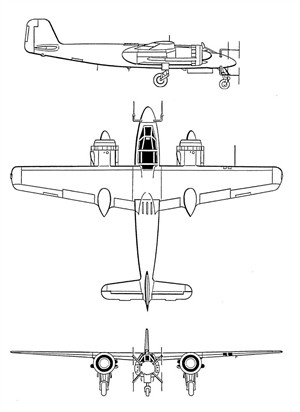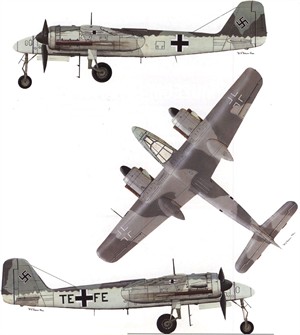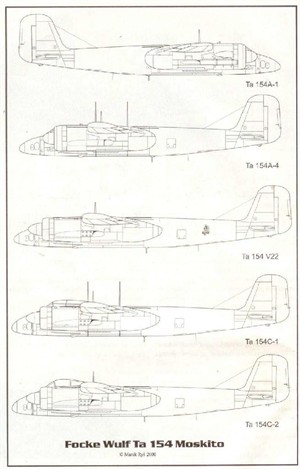| Type |
A-1 2-seat fighter |
| Engine |
2 Junkers Jumo 213E Propellers: 3-bladed Junkers VS-9 wooden constant-speed propellers |
| Dimensions |
Length 12,45 m , height 3,5 m, span 16 m, wing area 32.4 m2 , |
| Weights |
Empty 6600 kg, loaded 8930 kg , 534 km/h at sea levelmax. take off weight 9550 kg, fuel 1500 l in 2 fuselage tanks |
| Performance |
Max.. speed 650km/h at 7090 m, cruising speed , range 1365 km at 7000 m, 1860 km with 2 300 l extra tanks , endurance , service ceiling 10900 m , climb 15 m/sec., to 8000 m 14 min. 30 sec. |
| Armament |
2 20 mm MG 151/20 200 rpg., 2 x 30 mm nose-mounted MK 108 110 rpg.{Ta 154C) + 2 x fuselage-mounted Schräge Musik 30 mm MK 108 cannon |
| Equipment |
FuG 218 Neptun radar FuG 212 Lichtenstein C-1 FuG 220 Lichtenstein SN-2 FuG 350 Naxos Z radar detector (to home in on H2S radar)
Revi 16B gunsight |
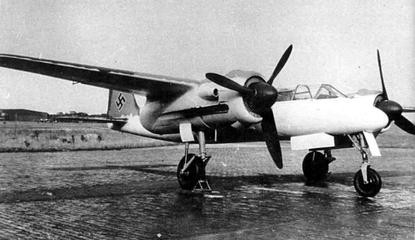
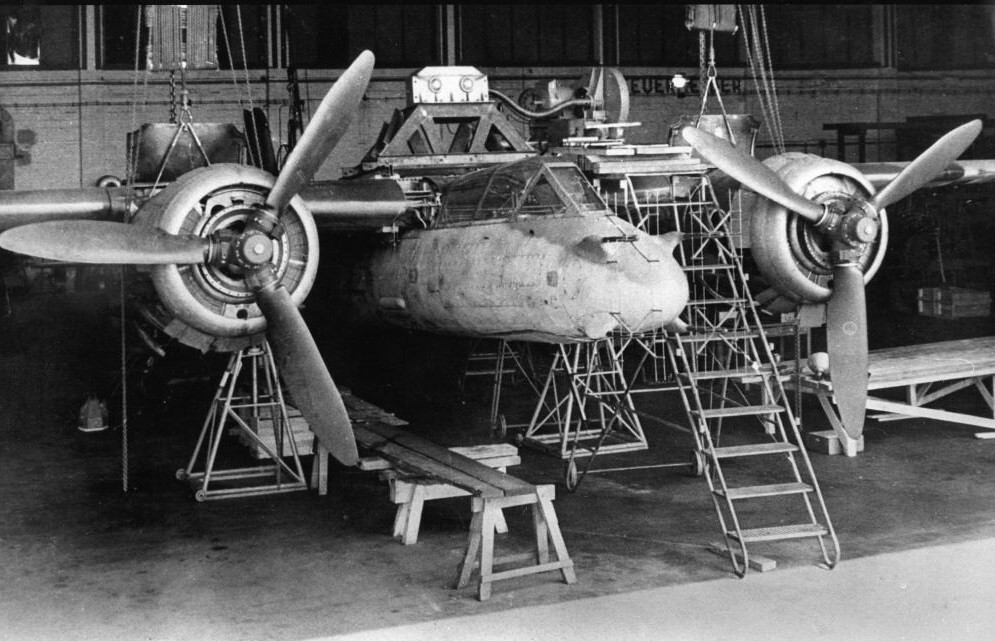
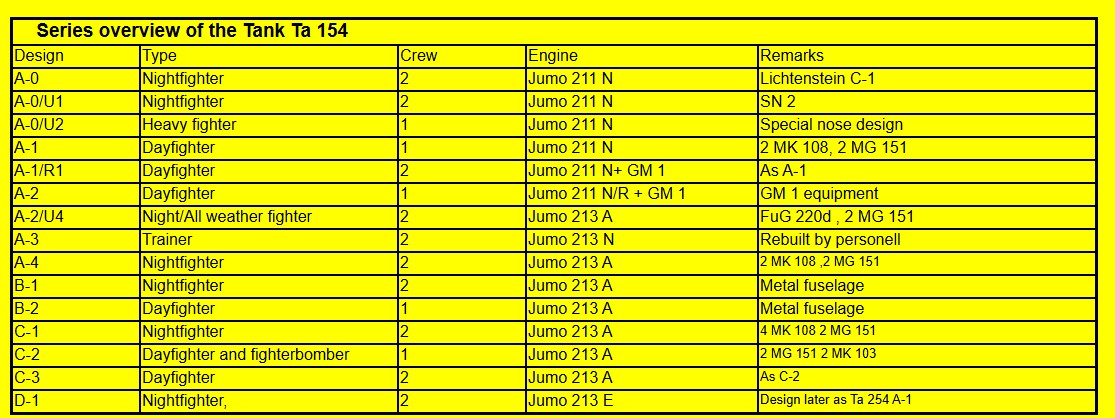
The Focke-Wulf Ta 154 Moskito was a fast twin-engined night fighter aircraft designed by the German aeronautical engineer Kurt Tank and produced by the aircraft manufacturer Focke-Wulf. It was unofficially named Moskito due to its similarities with the de Havilland
The Ta 154 commenced development in 1942 and was worked on during much of the latter half of the Second World War. It was designed to replace variants of the Messerschmitt Bf 110 and Junkers Ju 88 and function as a specialised night fighter. As per a stipulation issued by the Reichsluftfahrtministerium (RLM), wood comprised over half of the material needed to build the Ta 154. A special phenolic resin adhesive called Tego film was used to bond sections together. It was originally designated Ta 211 in reference to the intended Jumo 211R engine, although it was subsequently decided to adopt the more powerful Jumo 213 powerplant instead. Following a review of Focke-Wulf's submission, a development contract was issued to the company during late 1942.
On 1 July 1943, the prototype Ta 154 V1 performed its maiden flight; it was piloted by Kurt Tank. One of the early prototypes undertook competitive flight testing against both the Heinkel He 219 and the Junkers Ju 388, besting both of these rival aircraft. During March 1944, even though the first eight pre-production aircraft were yet to be completed, the Jägerstab decreed that 37 Ta 154s ought to be completed by May 1944 and that 250 aircraft were to be produced each month by November 1944.[3] This schedule proved highly unrealistic in light of various technical and logistical issues, with key parts (such as engines) not being available in sufficient quantity. Perhaps most crucially, the only factory that produced Tego-Film, in Wuppertal, was bombed by the RAF while replacement bonding agents proved to be inferior and a source of catastrophic mid-flight structural failures.
During September 1944, amid a complete production stoppage, the RLM opted to terminate the Ta 154 programme. Only a few production standard aircraft were completed, and these proved to possess less impressive performance than the prototypes. Several pre-production aircraft were also converted for operational use. Several Ta 154s were flown by Nachtjagdgeschwader 3 (Night Fighter Wing 3) while a handful are believed to have been also used as training aircraft for jet pilots. Furthermore, at least three Pulkzerstörer (Formation Destroyer) and Mistel parasite fighter schemes were mooted for the type.
On 1 July 1943, the prototype Ta 154 V1, which was outfitted with Jumo 211F engines and bore the Stammkennzeichen identification code TE+FE, performed its maiden flight in the hands of Kurt Tank. It was followed by V2 with Jumo 211N engines, which was kept at the factory for handling trials. V1 was later dispatched to Rechlin-Lärz Airfield to conduct fly-off testing against the competing He 219A as well as the new Junkers Ju 388. Reportedly, the aircraft reached almost 700 km/h (440 mph) and easily outflew the other two aircraft, but those were both fully armed and equipped with radar apparatus. In comparison, neither V1 or V2 were fitted with radar at this stage.
On 23 November 1943, the V3 prototype, which was also the first to be powered by the Jumo 211R engines and carry radar apparatus, made its first flight.The added weight of the guns and drag of the 32-dipole element Matratze radar antennas used on its UHF-band FuG 212 C-1 Lichtenstein radar unit slowed the aircraft by a full 75 km/h, although it was still somewhat faster than the He 219. The rest of the 15 prototypes were then delivered as A-0 models, identical to the V3. Some of these also included a raised canopy for better vision to the rear.
During March 1944, the Jägerstab decreed that Focke-Wulf should produce 37 Ta 154s by May 1944; in combination with other manufacturing assets, the production rate was somewhat unrealistically expected to reach 250 aircraft per month by November 1944.This schedule came in advance of the completion of the first eight pre-production aircraft, designated Ta 154A-0, which occurred in August of that year. These were briefly trialled by the service test unit before returning to development work. Transportation issues, which prevented subcontractors from delivering components, were highly damaging to the company's efforts to ramp up production; at one point, each airframe was reportedly taking 12,000 man-hours to produce. By June 1944, the Jumo 213 was finally arriving in some numbers, permitting the completion of several Ta 154 A-1s with these engines.
However, the Ta 154 received a fatal blow when the only factory that produced Tego-Film, in Wuppertal, was bombed out by the RAF, and the plywood glue had to be replaced by an alternative. While determined efforts were made towards this end, the new bonding agents proved to be neither as strong and even weakened the wood due to it containing too much acid and thus being corrosive. In July 1944, several Ta 154 A-1s reportedly disintegrated during high speed flight, allegedly due to the delamination and failure of the plywood wing. This same problem also critically affected the Heinkel He 162 Spatz, Ernst Heinkel's "Volksjäger" jet fighter program entry; the issue with the bonding agent was eventually resolved on this programme however.
Accordingly, production came to a halt in August 1944. One month later, the RLM officially cancelled the Ta 154, by which point Milch had been removed from his position and thus could no longer protect the programme. It is believed that about 10 production aircraft had been completed, 2 at Erfurt and 10 at Posen and a number of the A-0 preproduction aircraft were later modified to production standard. An unknown number of the aircraft served with Nachtjagdgeschwader 3 , and a few were later used as
raining aircraft for jet pilots
